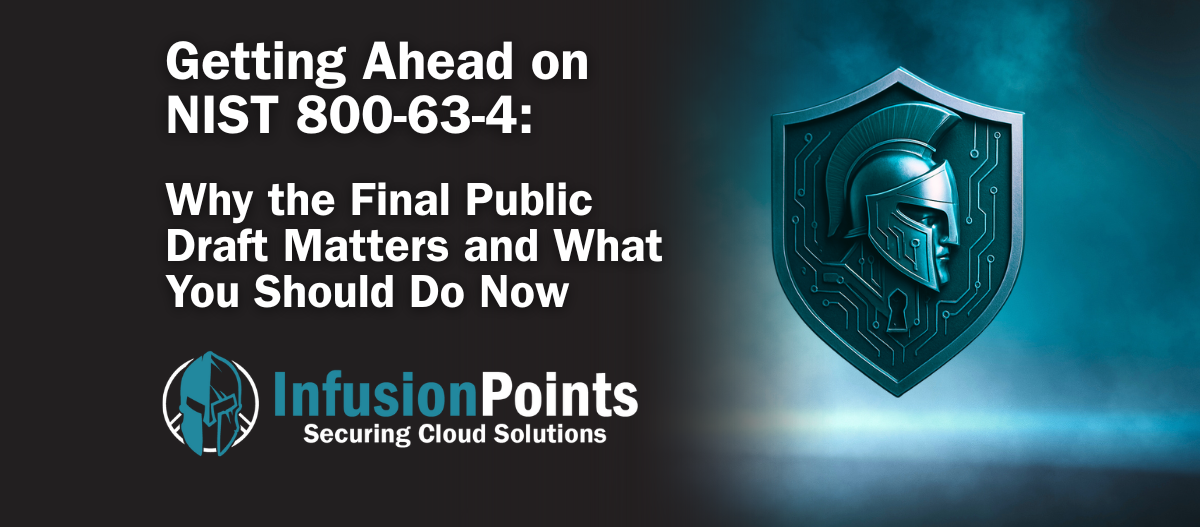Getting Ahead on NIST 800-63-4: Why the Final Public Draft Matters and What You Should Do Now
As organizations modernize their security architectures, identity has become the critical control point for verifying trust, enforcing access, and reducing risk across digital systems. With the release of the Final Public Draft (FPD) in July of 2025, agencies and contractors face a significant inflection point. The shift from the Second Public Draft (2PD) to the final version shows a new vision for digital identity; one that prioritizes phishing-resistant authentication, stronger identity proofing, and continuous risk evaluation.
At InfusionPoints, we work with federal and commercial clients who face the challenges of legacy Multi-Factor Authentication (MFA) solutions and phishing-resistant adoption. This blog aims to break down what has changed, why it matters, and how you can prepare to align your systems and be prepared for the future of 800-63.
Understanding the Shift: 2PD to FPD
The 2PD of NIST SP 800-63, published in August 2024, opened the door for public feedback on major revisions to identity proofing, authentication and federation. The FPD incorporates that feedback, locking in the normative language and formalizing many requirements.
For identity architects, compliance leads, and security engineers, the finalization of this standard means the clock is ticking not just for awareness, but for implementation of alignment. Frameworks such as FedRAMP, DoD IL4/5 and CMMC are already incorporating NIST SP 800-63 Terminology and assurance concepts into their Identity and Authentication (IA) control families. As these programs evolve toward phishing-resistant MFA and stricter proofing expectations, systems that don’t align with the SP 800-63-4 will face increasing audit scrutiny, ATO delays, or the need for costly retrofits. Decisions made today about authenticators, federation and proofing process should anticipate the final language to ensure compliance and minimize rework.
What’s New in SP 800-63-4 and Why it Matters
The revisions go far beyond an editorial cleanup. They redefine what “assurance” means in modern identity systems and close gaps that attackers have exploited in recent years.
1. Phishing-Resistant Authentication is Now the Expectation
The final standard cements what many security leaders have anticipated for a long time: shared secrets and OTPs are no longer sufficient. SP 800-63-4 pushes organizations toward cryptographic authenticators that validate both possession and origin, rendering common phishing techniques ineffective.
Key Takeaways
- Phishing-resistant MFA (e.g., FIDO2/WebAuthn, PIV/CAC, hardware keys) is now central to AAL2 and AAL3 compliance
- Syncable passkeys (cloud-backed credentials) are conditionally acceptable at AAL2 if the synchronization is secure and cryptographically verifiable.
- To quality, the synchronization fabric (e.g., Apple iCloud Keychain, Google Password Manager, Microsoft Authenication) must:
- Protect private keys with strong encryption,
- Authenticate synchronization events with a phishing-resistant factor, and
- Ensure keys cannot be exported or cloned without authorized user action
- To quality, the synchronization fabric (e.g., Apple iCloud Keychain, Google Password Manager, Microsoft Authenication) must:
- Push-based MFA and SMS OTP are not phishing-resistant and should be phased out where feasible.
For organizations relying on PIV/CAC cards, these updates reinforce their strength but also introduce stricter binding requirements between the authenticator and the federated assertion to prevent replay or impersonation attacks.
2. Identity Proofing and Enrollment are Getting Stricter
SP 800-63-4 provided updates for Identity Assurance Levels (IALs) to account for modern fraud risks, requiring stronger defenses against:
- Deepfakes and forged media
- Injection attacks in remote enrollment flows
- Synthetic identity creation
A quick anecdote can provide some context here:
In early 2024, a Hong Kong based company employee of Arup, a UK engineering and design firm, was deceived during a video conference with what appeared to be their CFO and other colleagues (all deep-faked). The employee carried out 15 transfers totaling HK$200 million (~USD $25 million) to fraudsters’ accounts.
Remote proofing now calls for tamper detection, cross-validation with authoritative sources and fraud telemetry. For contractors onboarding users across distributed environments, these will be essential.
3. Federation Assurance (FAL) and Assertion Binding Are Enhanced
Federated identity is now expected to include:
- Cryptographic binding of assertions to authenticators
- Revocation controls and privacy-preserving claims
- Support for user-controlled wallets and decentralized identity models
This validates that an attacker who steals a token or session ID cannot reuse it outside the intended context; this is a common vector in modern attacks.
4. Continuous Risk Evaluation Becomes Mandatory
Identity is no longer static. SP 800-63-4 introduces the concept of continuous evaluation; monitoring authentication events, device posture, anomalies and fraud signals after enrollment. This continuous assurance model aligns closely with zero trust principles and requires organizations to integrate real-time telemetry into IAM systems.
5. Usability, Equity, and Accessibility Are Now Core Requirements
The new guidelines embed equity and inclusivity into digital identity design. Systems must:
- Support a diverse user base (e.g., those without smartphones or with accessibility needs)
- Provide consistent outcomes across demographics
- Avoid disproportionate failure rates for any user population
This marks a shift from security-only thinking toward secure and equitable access, which is a key consideration for public sector and citizen-facing systems.
Why Action Should be Taken Now
Compliance Pressure Is Rising: Federal programs and contracts will soon reference SP 800-63-4 directly. Waiting until the final enforcement wave risks audit findings, ATO delays, or loss of eligibility.
Why Early Adoption is Beneficial: Reworking IAM after deployment, especially when it involves PIV/CAC integration, federation flows and MFA, is far more expensive than aligning early.
Threats Are Evolving Faster Than Standards: Phishing, credential stuffing and MFA attacks are accelerating. Moving to phishing-resistance isn’t just compliance, it’s survival.
How InfusionPoints Can Help
InfusionPoints combines deep identity expertise with compliance engineering though our XccelerATOr, XBU40, Command Center and VNSOC360° services. Through our managed services, we help organizations:
- Map controls to NIST SP 800-63-4
- Deploy phishing resistant MFA and modern federation architectures
- Monitor identity events for continued assurance.
- Prepare for FedRAMP and DoD ATOs under the new standard
Final Thoughts
The jump from 2PD to FPD is more than a revision; it’s a paradigm shift in how digital identity is defined, deployed and defended. Identity is no longer just a gatekeeper; it’s now a continuously evaluated, cryptographically anchored, and user-centric control that underpins every access decision. Organizations that embrace these updates aim to position themselves ahead of compliance curves and threat actors alike.
Our key takeaways from these updates include:
- Phishing-Resistant MFA is the New Baseline: Shared secrets and OTPs no longer meet the bar for AAL2 or AAL3. Modern authenticators like FIDO2/WebAuthn, PIV/CAC and hardware keys are essential for trust and compliance
- Syncable Passkeys Expand Usability Without Sacrificing Security: For the first time, cloud-backed credentials are conditionally acceptable at AAL2, enabling strong MFA across devices when paired with encrypted, authenticated sync.
- Proofing Must Defend Against AI-Driven Fraud: With deepfakes, synthetic identities, and injection attacks on the rise, organizations must integrate liveness checks, tamper detection and fraud telemetry into onboarding workflows
- Federation Requires Cryptographic Binding: Tokens and assertions must be verifiably tied to authenticators, reducing risk from replay and impersonation in SSO and cross-domain trust.
- Continuous Risk Monitoring is Now Expected: Identity assurance is an ongoing process, not a one-time event. Integrating telemetry, anomaly detection, and adaptive reauthentication is key for zero trust readiness.
- Equity and Accessibility Are Compliance Factors: Systems must serve all users fairly, avoiding disproportionate failure rates or barriers to access, especially in public and citizen-facing applications.
Early adopters who align with SP 800-63-4 today stand to benefit in many ways:
- Stronger defenses against evolving threats
- Smoother audits and ATO approvals
- Future-proofed architectures built on zero trust principles
- Greater trust with customers, regulators and partners
Aligning with SP 800-63-4 isn’t just about compliance. It’s about building resilient, phishing resistant trust in every transaction.
Sources:
SP 800-63-4, Digital Identity Guidelines | CSRC


